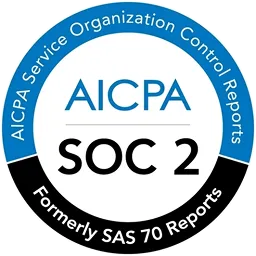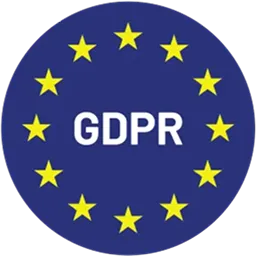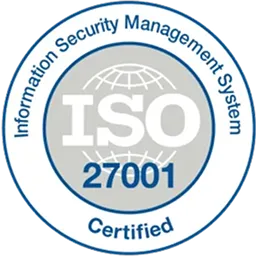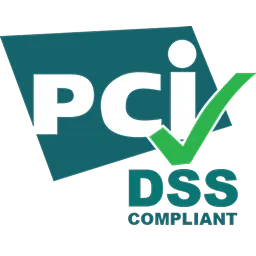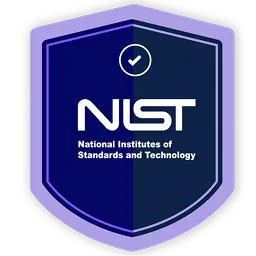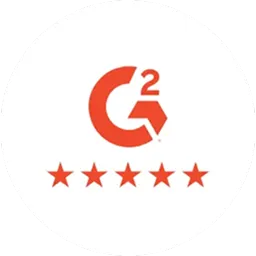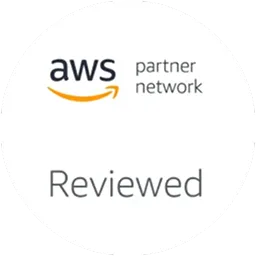SOX testing ensures your organization’s financial data is accurate, secure, and compliant. But how can you effectively test internal controls without overlooking critical risks? This article explains the key steps of SOX testing and shares best practices to help you conduct testing efficiently and effectively.
Ensuring compliance with the Sarbanes-Oxley Act (SOX) can feel overwhelming. The process involves testing controls, validating access, and reviewing processes- tasks that are time-consuming and critical for identifying gaps and weaknesses. Failing to address these vulnerabilities could lead to audit failures, hefty penalties, or worse, loss of investor trust.
Imagine this: Your financial systems are compromised by unauthorized user access. An audit uncovers the oversight, leading to severe consequences for your organization. Proper SOX testing can prevent such scenarios by strengthening internal controls and ensuring systems remain secure and compliant.
SOX testing goes beyond compliance- it verifies that internal controls effectively safeguard sensitive financial data and prevent material misstatements in financial reporting. It promotes transparency, security, and accountability, helping organizations identify risks early before they turn into costly risks.
Staying up-to-date with SOX testing doesn’t just help you pass audits—it strengthens your defenses against fraud and data breaches, ensuring your organization is better prepared to handle potential risks. In the following sections, we’ll explain what SOX testing involves and how you can implement it.
What is SOX Testing?
SOX testing ensures the accuracy and security of your organization's financial data and internal controls, verifying compliance with the SOX Act, designed to combat financial fraud.
To comply with SOX, organizations must implement procedures to protect financial records and systems. SOX testing focuses on evaluating internal controls, IT systems, and risk management practices.
The testing process involves both internal and external controls to verify the integrity of financial reporting. Key areas assessed during SOX testing include:
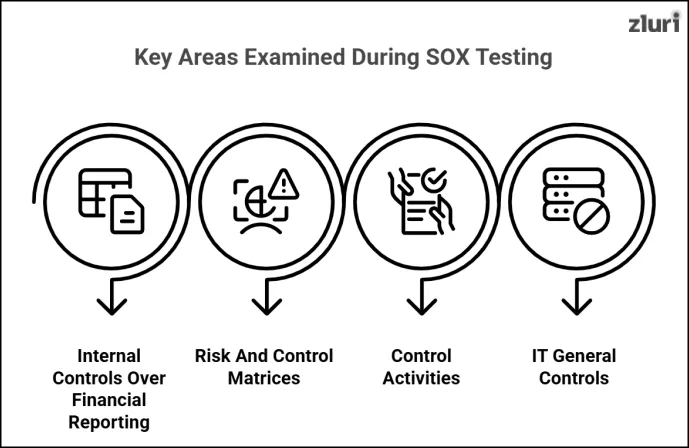
- Internal Controls Over Financial Reporting (ICFR): These controls ensure the accuracy and reliability of financial reports. ICFR testing reviews processes such as transaction approvals, account reconciliations, and reporting standards. Strong ICFR is essential for trustworthy financial statements.
- Risk and Control Matrices (RCM): The RCM connects identified risks with controls. Auditors use it to validate whether risks are managed appropriately. A well-kept RCM ensures that no critical risks are overlooked.
- Control Activities: These practices, such as segregation of duties, user access reviews, and approval workflows, help mitigate financial risks. SOX testing ensures these controls are consistently applied, ensuring accountability and transparency.
- IT General Controls (ITGC): ITGC protects the systems supporting financial reporting, covering areas like system access, data backups, and change management. ITGC testing ensures financial data is secure and systems operate as expected, maintaining compliance and preventing breaches.
Also Read: Learn how to create a disaster recovery plan with this blog post.
A Brief History of SOX Testing
The Sarbanes-Oxley Act was enacted in 2002 in response to high-profile corporate scandals involving fraudulent financial practices at Enron and WorldCom. These cases revealed severe weaknesses in internal controls, leading to billions of losses for investors and triggering public outrage over corporate accountability.
To restore investor confidence and protect financial markets, the U.S. Congress passed the SOX, requiring public companies to enforce strict controls over their financial reporting processes. Two key provisions of the law- Sections 302 and 404- place direct responsibility on management to ensure the accuracy of financial records and the security of financial systems.
Also Read: 404(a) vs 404(b) In SOX Compliance - 6 Key Differences
Section 302 mandates that CEOs and CFOs certify the accuracy of financial statements, while Section 404 requires companies to document, test, and evaluate internal controls to prevent fraud and errors.
Over time, SOX testing has expanded to include IT systems due to their central role in storing, processing, and securing financial data. Today, it remains a critical process for maintaining compliance and ensuring data integrity in the digital age.
Also Read: To understand the difference between both the compliance standards, you can go through this blog post- Sox 302 vs. 404
4 Key Steps Involved in SOX Testing
Here are the key steps of SOX testing.
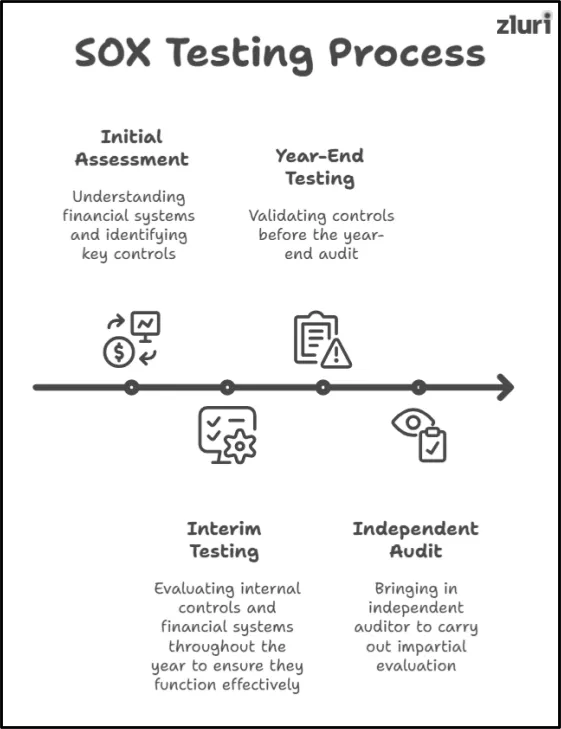
1. Initial Assessment
The initial assessment is the starting point of SOX testing, providing a roadmap for the entire process. This step focuses on understanding financial systems, identifying key controls, and mapping out workflows to evaluate potential risks and gaps.
During this phase, the team conducts a detailed analysis of the internal control environment, including financial processes, critical systems, and data access points. It also involves documenting workflows, security measures, and past SOX audit results to highlight areas that need improvement.
The goal is to prioritize controls most critical to financial reporting and identify all risks early. This structured approach can save time, reduce errors, and establish a solid foundation for the testing process.
2. Interim testing
Interim testing plays a critical role in the SOX compliance process. It focuses on evaluating internal controls and financial systems throughout the year to ensure they are operating effectively before the final audit.
During this phase, the team and auditors test key controls, such as access controls, system configurations, and data accuracy checks. These tests verify whether systems protect sensitive information, prevent unauthorized access, and ensure data integrity. Any weaknesses or failures identified are documented and addressed before the year-end audit.
By conducting interim testing, businesses can identify control gaps early, giving them time to fix issues and strengthen compliance before the final review. This proactive approach reduces last-minute pressure, minimizes audit risks, and ensures a smoother compliance process.
Ultimately, interim testing helps maintain the effectiveness of internal controls throughout the year, preventing compliance failures and protecting stakeholder confidence.
3. Year-end testing
Year-end testing is the final and most critical step in the testing process. It validates that internal controls over financial reporting remain effective before the year-end audit.
During this phase, teams and auditors review interim testing results, re-test key controls, and verify that any system updates since the last test have not introduced new risks. Key areas evaluated include access management, system configurations, and financial data accuracy. Any control failures are documented and resolved promptly to avoid compliance issues.
This final review helps businesses double-check controls, reduce non-compliance risks, and ensure readiness for the audit process. It also gives auditors confidence in the control environment and demonstrates that systems are secure, accurate, and compliant.
Year-end testing completes the SOX compliance process, reinforces stakeholder trust, and minimizes the risk of penalties or reputational damage.
4. Testing by independent auditors
An essential part of the SOX testing is conducted by independent auditors, who provide an impartial evaluation of the company's internal controls and financial systems.
These auditors thoroughly review the key controls, critical systems, access controls, and financial processes to ensure they comply with SOX regulations. Their primary role is to verify that internal controls are functioning as intended and to confirm that any issues identified during interim or year-end testing have been resolved.
Independent auditors bring a fresh perspective and often uncover gaps or weaknesses that internal teams might have missed. Their findings objectively assess the company's compliance posture, ensuring that all systems and controls are robust and effective.
This audit is the final check before the official audit, providing transparency and instilling confidence among stakeholders, investors, and regulators. The independent audit helps ensure the integrity of the company's financial reporting and compliance with SOX standards.
Also Read: If you want to know more about SOX audit, go through SOX Audit: Step-by-Step Process.
5 Best Practices for SOX Testing
Let’s discuss the various best practices that will make your SOX testing effective.
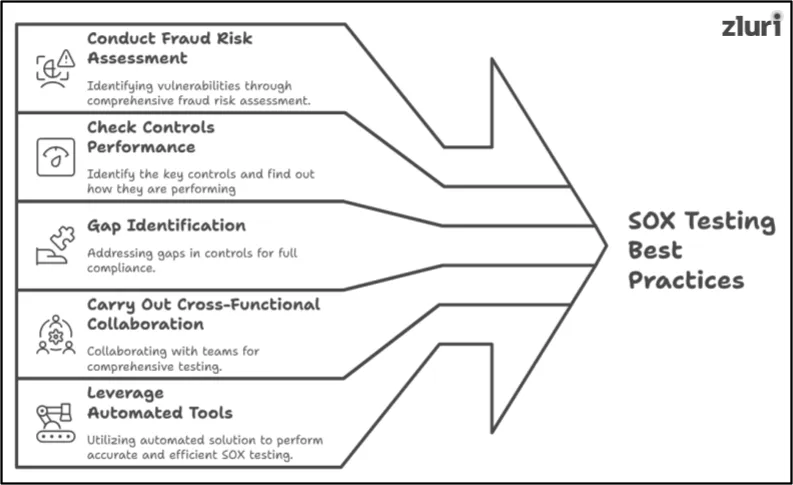
1. Uncover vulnerabilities Early with a Fraud Risk Assessment
A fraud risk assessment is a great way to pinpoint where fraud could happen in your systems or financial processes. For example, you might discover that employees who can both approve and process payments could potentially manipulate transactions. This proactive approach helps you catch risks early so your SOX testing can focus on the areas that need attention the most. It strengthens your compliance efforts and reduces the chances of fraud or errors slipping unnoticed.
When you run a fraud risk assessment, it will highlight weaknesses in your IT controls, like gaps in access management. Addressing these areas ensures your financial systems stay secure and can make the testing more efficient and effective. By fixing these issues, you prevent fraud and create a smoother testing process.
This practice also strengthens internal controls and aligns IT processes with financial goals. By identifying and addressing vulnerabilities, you reduce the risk of non-compliance, improve transparency, and make your SOX testing faster and more accurate.
2. Maximize SOX Testing Efficiency by Focusing on Key Controls
Focusing on fewer, high-impact key controls is a smart way to improve your SOX testing efficiency. For example, instead of testing every control, focus on the ones that affect your financial reporting, like the access controls to your accounting software. This means you spend your time and resources on the areas that matter the most, saving you time and making your testing process more effective.
By narrowing your focus, you reduce unnecessary complexity and make everything clearer. For instance, instead of testing each system’s access control separately, you can streamline and focus on the critical ones, which cuts down on time and reduces errors.
This approach doesn’t just make things easier to manage; it also makes your SOX testing more accurate. You’ll be able to simplify your documentation, reporting, and audits, making everything smoother. Focusing on what matters improves visibility and eliminates redundancy, so your team can work smarter, not harder.
3. Address SOX Control Gaps Early to Ensure Full Compliance
Assessing gaps in your SOX controls is one of the most important steps for effective testing. For example, you might realize that certain financial systems haven't been regularly checked for unusual access, leaving them open to potential risk. By spotting gaps early, you can take corrective actions before issues grow bigger, ensuring you stay compliant and reducing any risks to your financial data.
This process shows you where controls may be outdated or simply missing. For example, you might find that certain systems don’t have multi-factor authentication (MFA) in place for sensitive data. Fixing these gaps makes your systems stronger and more reliable, which leads to smoother SOX testing and fewer audit findings or non-compliance penalties.
Also Read: Looking for some multi-factor authentication tools? Go through this blog post for an expert-curated list.
Addressing control gaps early also saves you time during audits and helps keep things running smoothly. It allows you to confidently align your controls with SOX requirements, ultimately improving the quality of your testing and making future compliance easier to manage.
4. Enhance SOX Testing with Cross-Functional Walkthroughs
One of the best ways to make your SOX testing more effective is by doing walkthroughs with cross-functional teams. This means collaborating with IT, Finance, and Operations departments to review processes and controls. For example, working with your finance team to review how IT manages user access can reveal issues like outdated user roles or missing permissions.
Team members can share their insights during these walkthroughs and point out potential gaps. This collaboration ensures everyone is aligned on compliance goals while allowing you to validate controls and address any concerns before they become problems.
Having cross-functional teams involved makes your testing more thorough. Different perspectives will often reveal issues that might have been overlooked otherwise. It also helps improve communication between departments and fosters a sense of shared responsibility. As a result, the entire process becomes more efficient, and your audit preparation will go much smoother.
5. Boost SOX Testing Accuracy & Efficiency with Automated Tools
Using automated tools is a game changer when it comes to SOX testing. Automation handles repetitive tasks like data collection, control testing, and reporting so your team can focus on higher-priority tasks. For example, automation can quickly spot changes in your financial systems, saving your team hours of manual testing and reducing the chance of human error.
Automated tools also provide real-time monitoring, flagging issues like unusual system access or unauthorized data changes. This helps you catch problems as soon as they happen, improving the accuracy of your testing. Plus, it makes reporting so much easier, with consistent and reliable outputs that are ready for your auditors.
These tools make testing more efficient and enhance visibility into your controls. They help you identify gaps, track performance, and ensure your controls stay up to date as compliance needs evolve. This strengthens your testing strategy, boosts audit readiness, and ensures compliance is met smoothly.
Also Read: To prepare your organization for the upcoming SOX compliance audit, go through this SOX Readiness Action Plan.
Simplify SOX Testing with Automated Access Reviews
The primary goal of SOX compliance is to ensure the accuracy, integrity, and security of financial reporting. It promotes transparency and helps organizations prevent fraudulent activities. To achieve this, a thorough audit must be conducted to verify that internal controls - such as access controls - are properly implemented and functioning to protect financial data during the SOX testing phase.
One key element in verifying these controls is through regular access reviews. During SOX testing, auditors check who has access to financial systems and data, ensuring only authorized users can make changes.
Conducting access reviews manually, however, can be cumbersome. Tracking user permissions across various systems is time-consuming and prone to errors, especially when dealing with large volumes of data. Automated tools like Zluri can streamline this process.
Zluri automates the access review process, evaluating relevant applications and identifying which users have access to financial data. This helps auditors pinpoint any risky access or excessive permissions, key factors during SOX testing.
If any inappropriate access is identified, Zluri allows you to immediately remediate it by modifying or revoking permission, ensuring compliance with SOX standards.
For example, if an employee in your Marketing department has access to finance-based tools like ZohoBooks, that access can be revoked during the access review. This ensures sensitive financial data remains secure from risks such as data breaches.
When it’s time to present evidence for external auditors, Zluri generates access review reports that are ready to be presented during SOX testing. Auditors can easily review user access and permissions using these reports, speeding up the audit process.
By automating access reviews and simplifying evidence collection, Zluri helps you maintain SOX compliance, and reduce errors- all while saving time.
Let’s take Monday as an example to see how you can automate access review in Zluri.
Frequently Asked Questions (FAQs)
1. What is compliance testing?
Compliance testing, also referred to as conformance testing, is a type of software testing to determine whether a software product, process, computer program, or system meets a defined set of internal or external standards before it's released into production. Internal standards are standards set by an organization.
2. What are financial disclosures?
Financial statement disclosures are additional information included at the end of a financial statement presentation. These addendums provide insight to governing bodies, investors, employees, and the general public.
3. What are the 7 internal accounting controls?
7 Internal controls every accounting team needs to implement
- Separation of duties
- Access controls
- Physical audits
- Standardized financial documents
- Periodic trial balances
- Periodic reconciliations
- Approval workflows


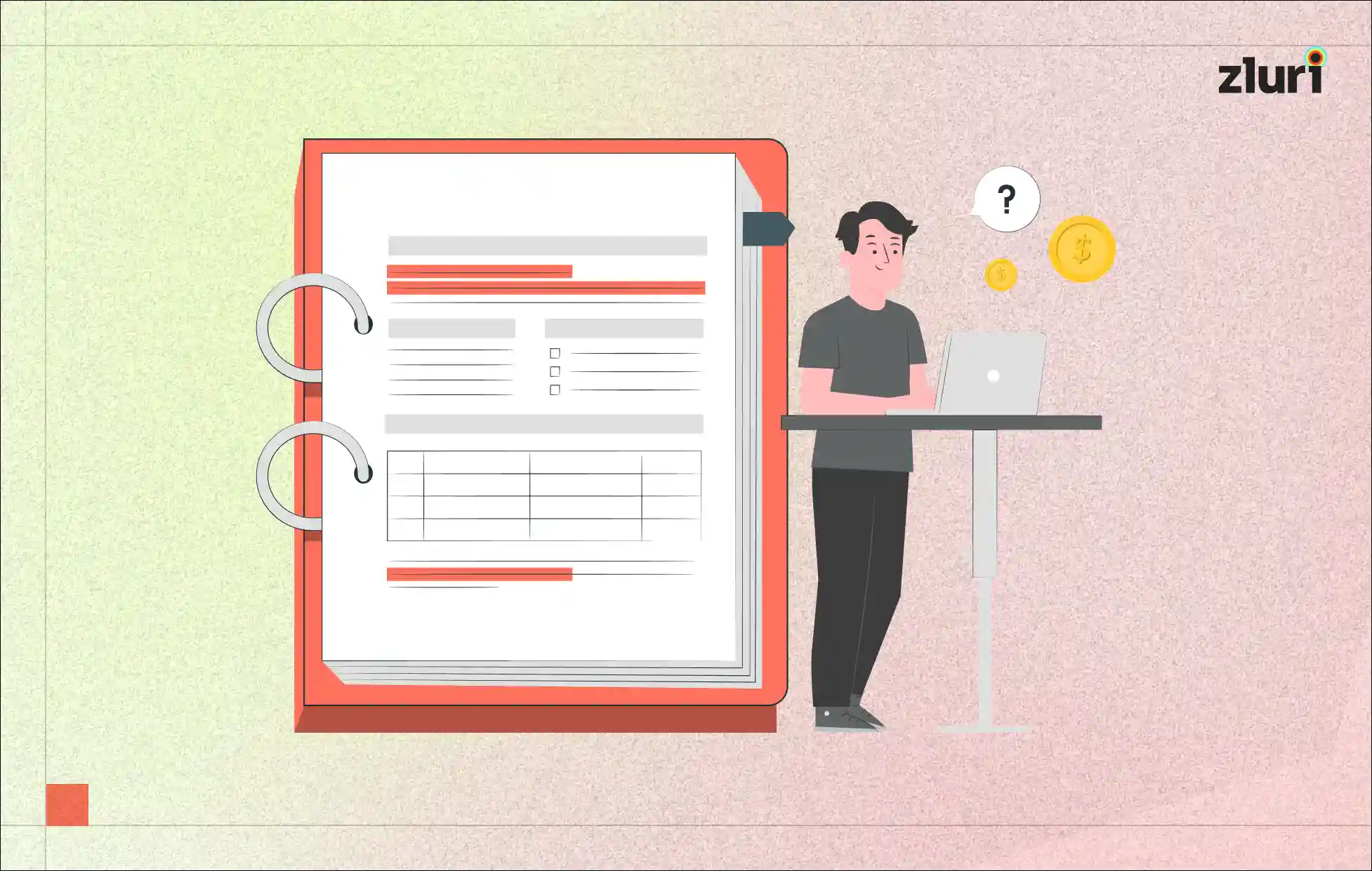



.svg)



